Investigator Characteristics & Patient Recruitment in ALLHAT
Applied Clinical Trials
Analysis of the largest antihypertensive trial ever offers useful blueprint for sites in boosting subject enrollment.
The ability of clinical research to produce valid conclusions depends upon successful subject recruitment.1 Eighty-five percent of clinical trials are extended due to insufficient recruitment.2 Consequently, study costs increase due to loss of study time and lead to delay in drug approval and presentation of important results.2,3 Compared to exclusively academic clinical trials, community-based clinical trial outcomes have the potential to observe large-scale effects and expand generalizability to a broad population because they operate within a variety of treatment centers across wide geographical regions.4 The Antihypertensive and Lipid-Lowering Treatment to Prevent Heart Attack Trial (ALLHAT), the largest antihypertensive trial ever conducted by any public or private sponsor, was a randomized, double-blind, active-controlled trial which adopted the community-based approach by including 42,418 high-risk participants recruited largely by their own treating physicians. ALLHAT successfully recruited large numbers of women (47%), African-Americans (36%), Hispanic Americans (19%), and persons with type II diabetes (36%).5,6 Such underrepresented populations were previously reported as difficult to recruit in community-based cardiovascular trials.7
Although study coordinators (SCs) exert an essential role in the clinical trial recruitment process, in community practice-based clinical trials, physician investigators, whose attitudes and characteristics define the clinic environment, also exert a strong influence on recruitment. Several physician-related variables tied to clinical trial participant recruitment have been identified: Bell-Syer and Moffett8 found investigators and practices recruited to primary care clinical trials early were more successful in enrolling study participants. Ramirez et al.9 looked at physician barriers to recruitment in multiethnic oncology trials in Texas and found no major difference in demographic factors between good and poor recruiters. However, several studies have noted that investigators who believe a clinical trial presents an undue burden to their work, fails to provide personal benefits, or has too complex a protocol tend to be poor recruiters.9-13 In addition, physicians who want to participate in clinical trials may not enroll their eligible patients due to concerns that their patients may not receive the treatment they believe is better, thereby influencing their perceived quality of care and hampering the patient/physician relationship.10
ALLHAT investigators went to great lengths to assure that the participants they enrolled had no medical contraindications to the study medications (or, conversely, compelling indications for any one antihypertensive class), and to assure that the participants fully understood and accepted the randomized design of the study. Although the study leadership respected the rights of investigators to alter antihypertensive treatment when, in their judgment, compelling clinical issues required it, the leadership also sought to recruit investigators with study equipoise, who accepted the tenets of randomized, controlled, “intention to treat” trials.
Previous studies have identified physician/investigator characteristics that influence recruitment.1-3,14-18 ALLHAT, unique in its large participant population with predefined population subgroups previously underrepresented in antihypertensive trials,6 successfully recruited clinics able to draw from their patient base to fulfill these recruitment goals. Here we draw from the ALLHAT experience with its large database to look at investigator characteristics that related to patient recruitment. We readily acknowledge the essential role played by SCs in recruitment and in all phases of clinical research. Many of the investigator characteristics that we describe here may apply to the SCs, especially as they assume more leadership roles in clinical research, and may serve to teach the entire research team more effective recruitment and clinical management skills. The primary objectives of this study are: 1) to describe the clinical investigator characteristics in ALLHAT, and, 2) to determine which physician/investigator characteristics were associated with successful participant recruitment.
Methods
The rationale and design for ALLHAT have been previously published.5 ALLHAT compared clinical outcomes of those assigned to one of three newer classes of antihypertensive medications-calcium channel blocker (CCB; amlodipine), angiotensin-converting enzyme inhibitor (ACE-I; lisinopril), and alpha-blocker (doxazosin)-with those assigned to the thiazide-type diuretic (chlorthalidone)-when each drug was used as first-step treatment with other drugs added to achieve a BP goal of <140/90. A
Click to enlarge
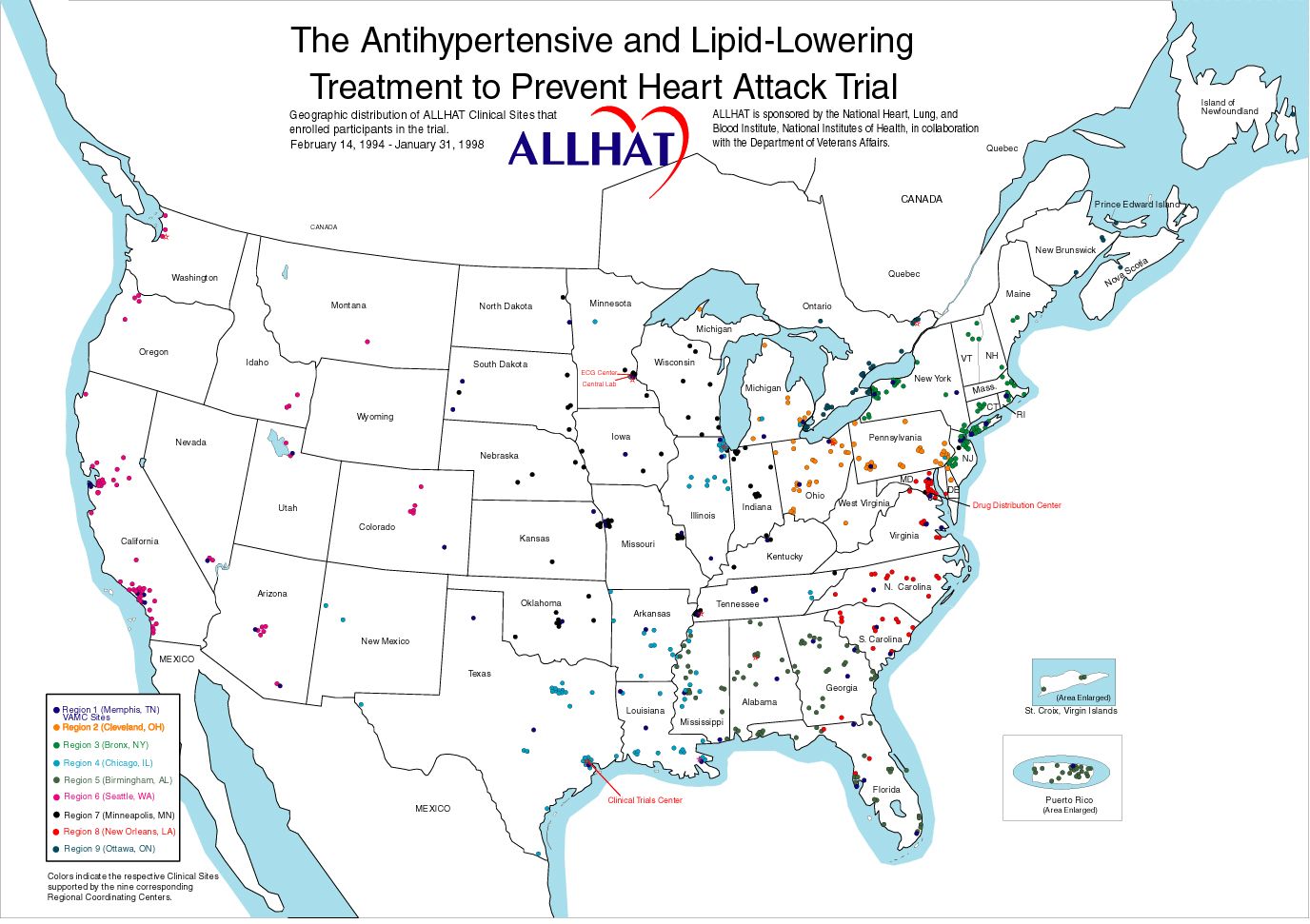
total of 42,418 high-risk hypertensive participants, ages 55 and older, from 623 sites in the United States, Puerto Rico, Canada, and the US Virgin Islands, were randomized between 1994-1998. The sites included academic medical centers, Veterans’ Affairs Medical Centers (VAMCs), private practices, community health centers, and health maintenance organizations, and were distributed across eight geographic regions and a ninth region composed of VAMC sites. A map indicating location of ALLHAT sites along with a description of major recruitment aims is shown at right. Each of the nine regions had one regional coordinating center (RCC) which directed 30 to 102 sites and was led by a physician-investigator and one or more regional SC (RSC), some of whom were nurses.
The RSCs monitored participant recruitment through baseline and visit form submission, as well as weekly reports created for each site. Participant selection was initiated through examination of potential participant charts at the study sites. Two pre-randomization visits assessed participant eligibility. Once eligibility was confirmed, the participant provided written informed consent, discontinued pre-study prescribed antihypertensive drugs (unless tapering or a “wash-out” period was required), and was subsequently randomized to one of four treatment components.5 The alpha-blocker arm of ALLHAT was terminated early in 2000;19 results of the other two treatment group comparisons were published in 2002.20 The population for this study included the 502 site principal investigators (PIs) who voluntarily completed and returned the ALLHAT investigator profile survey.
Clinical sites were recruited from 1994-1997, and participants from 1994-1998.21,22 An abbreviated physician orientation profile questionnaire, distributed to site physician/investigators in 2000, examined physicians’ attitudes and opinions regarding randomized controlled trials (RCTs). The original questionnaire had been pre-tested for validity and reliability;23 the abbreviated version was tested on members of the ALLHAT steering committee for acceptability, though no formal validation procedure was conducted. The survey captured characteristics in three main categories: demographics/practice type, physician’s views of RCTs, and investigator attitudes/experiences. An investigator identification number was sequentially assigned and allowed for non-identified tracking. In order to achieve an adequate response rate, if less than 50% of investigators returned the profile, a second copy was mailed to the non-responders. The investigator profiles were matched centrally with site and recruitment data.
Statistical analysis
A frequency distribution by type, size, and geographic region for sites was conducted for site recruitment and investigator characteristic data. A chi-square analysis of the association of each characteristic with successful recruitment was performed. In these analyses, the recruitment outcome was dichotomized by comparing sites that recruited at or above the overall site recruitment median of 46 participants with those that recruited fewer than 46 participants. The statistical significance of each association was reported as a p-value for the corresponding likelihood ratio statistic. A multivariate logistic analysis was performed to recognize independent associations of characteristics with successful recruitment, when adjusting for all other variables. A univariate logistic analysis was first done for each characteristic, and those with p <0.10 were included in the multivariate model. Backward elimination technique was used to build the multivariate logistic model, and all p-values <0.05 were kept in the final model. Given the many univariate and multivariate analyses performed, statistical significance at the 0.05 level should be interpreted with caution. A STATA 12 (STATACorp LP, College Station, Texas) was used for the statistical analyses.
Results
Table 1 at right provides responding investigator characteristics and indicates characteristics associated with generally successful recruitment. The majority (411/497, or 83%) of the responding ALLHAT investigators were male and
Click to enlarge

nearly 75% were between 40-59 years old. Two-thirds were Caucasian, 13% African-American, and 8% Hispanic. Sixty percent of sites were urban, 14% academic, 11% VAMC, and over half private or group practice. Seventy-four percent (28/38) of the Hispanic investigators were successful recruiters (p=0.015), as were 78% (42/54) of VAMC sites (p<0.0001). No data were collected about investigators who did not respond to the questionnaire.
Investigator research activities are described in Table 2 below. Over half (113/204, p=0.027) of the physician/investigators who were PIs of two or more concurrent research grants were successful recruiters. The majority of successful recruiters (79% vs. 21%, p=0.002) spent less than 25% of their time in research-related activities, and most continuing medical education focused on clinical care rather than research topics. The two-thirds of investigators who
Click to enlarge
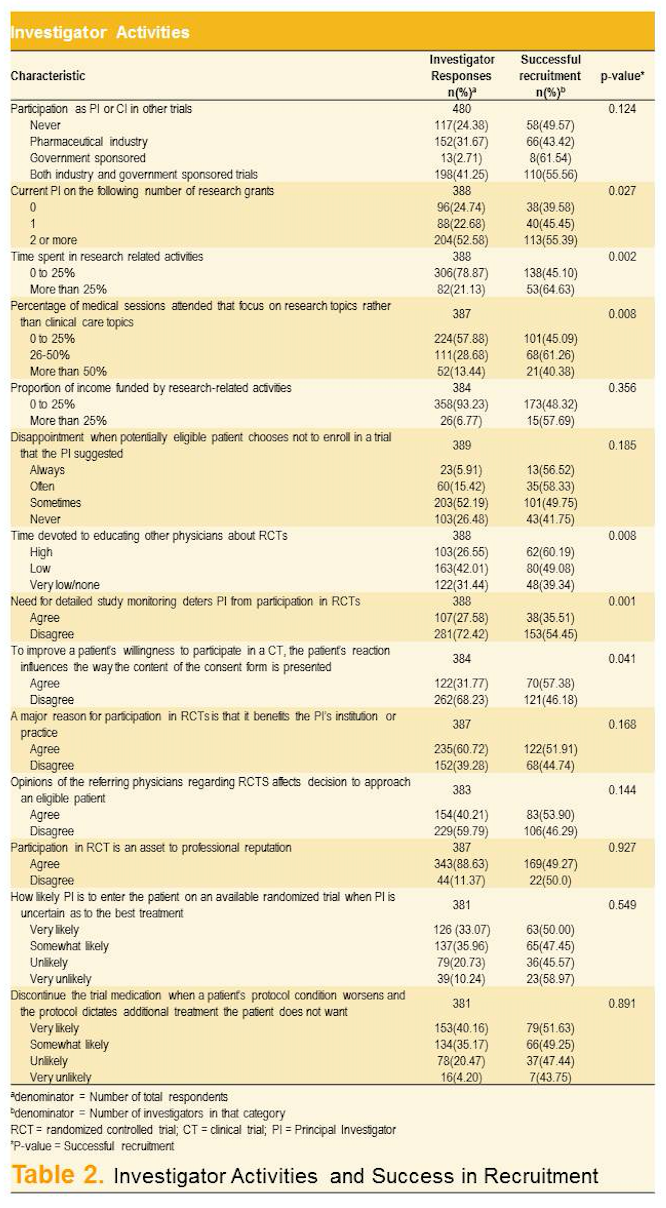
devoted time to educating other physicians about RCTs had greater recruitment success compared to those who reported very low/no time in this activity (p=0.008).
Investigator views on patient attitudes and rights are presented in Table 3 below. Investigators who were willing to spend additional time reviewing the consent form with a potential participant whose reaction
Click to enlarge
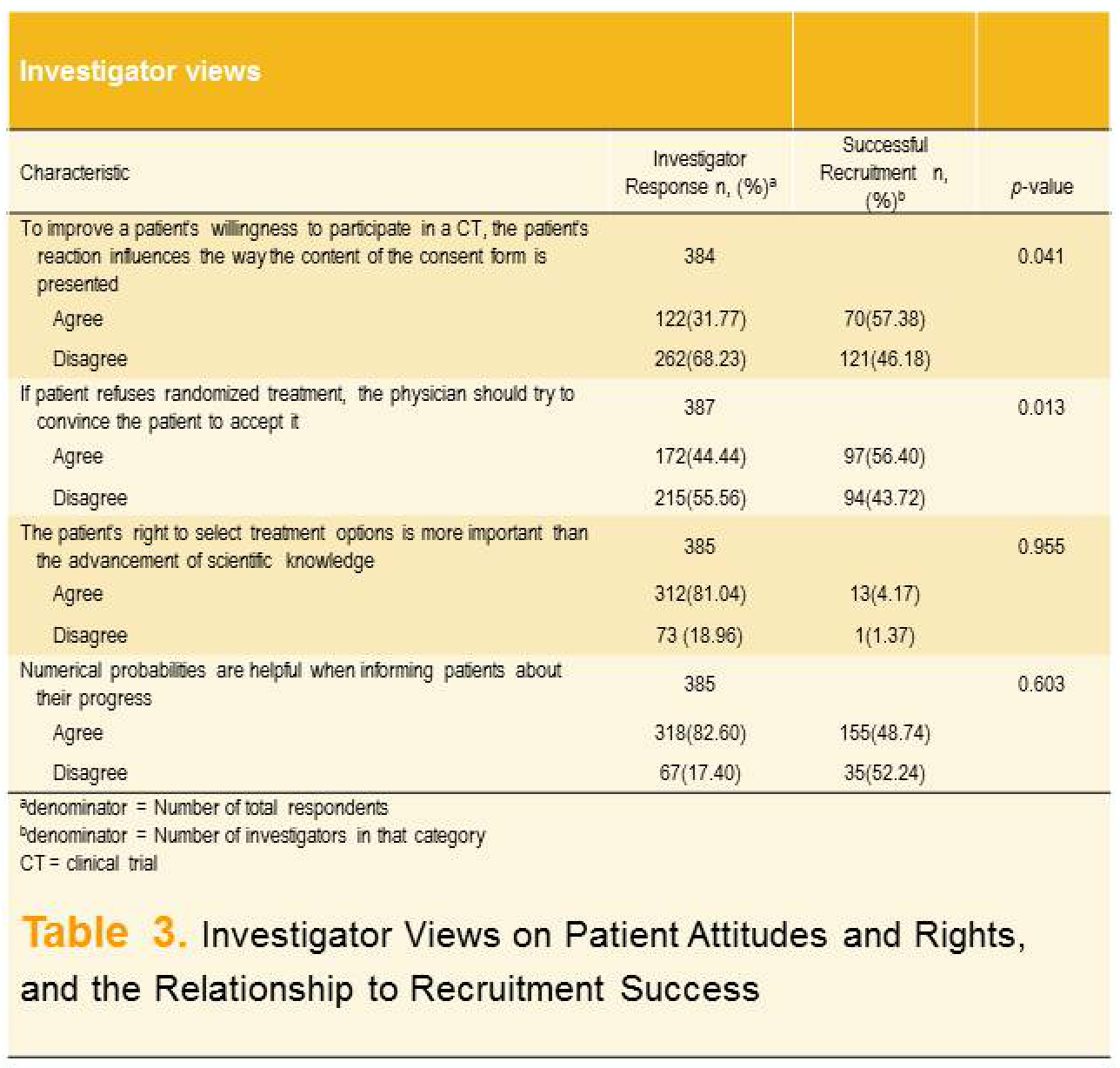
warranted additional clarification or explanation had greater success in recruitment (p=0.041).
Table 4 below describes significant characteristics among those included in the multivariate logistic model. The final model included 357 (71%) of the 502 investigators due to variation in the number who answered the respective questions. Hispanic ethnicity (odds ratio [OR], 3.698; p=0.037), urban setting (OR, 0.423; p=0.019), VAMC site (OR, 6.447; (p=0.002), more than two study staff (OR,
Click to enlarge
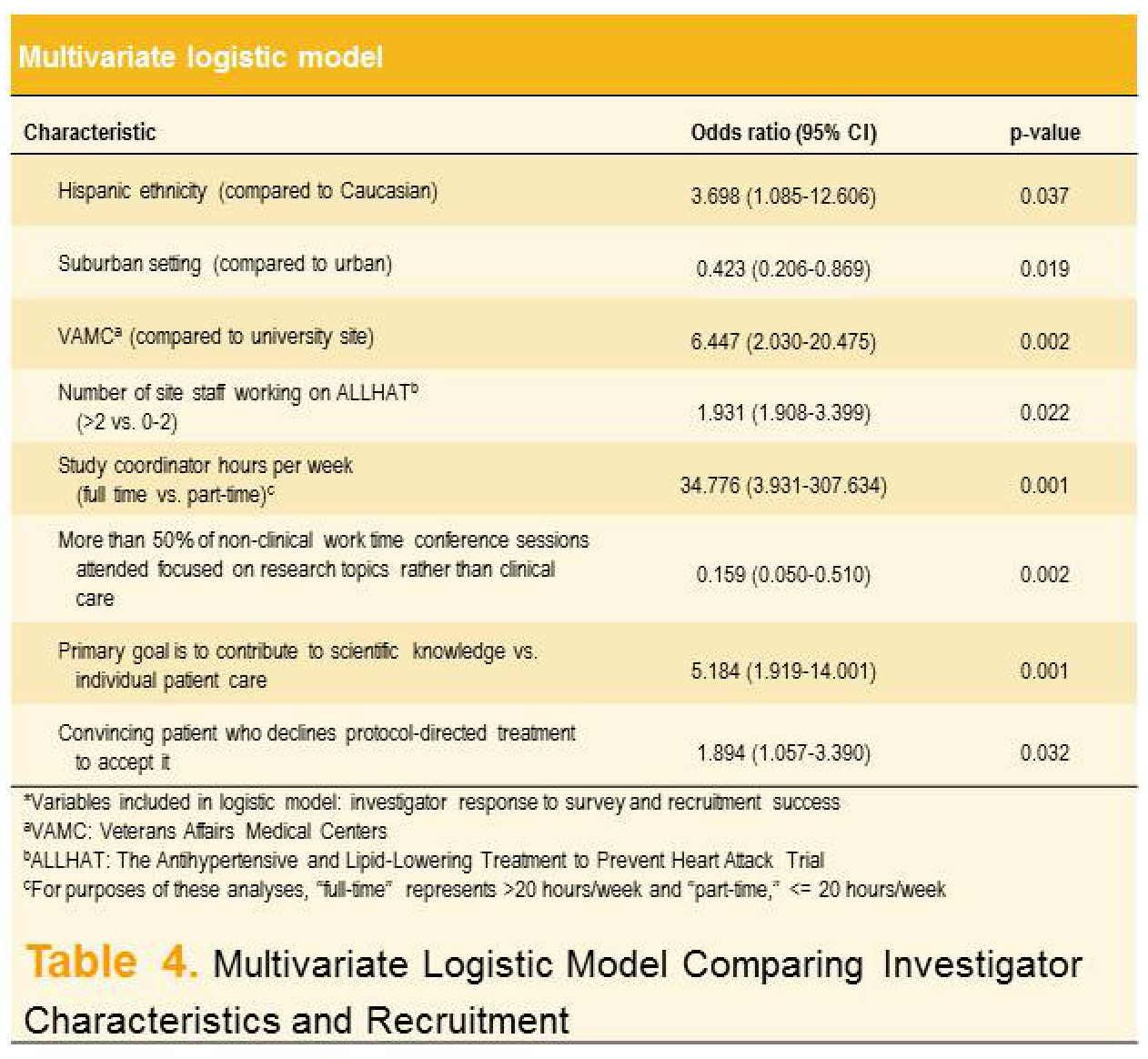
1.931; p=0.022), more than 20 dedicated study coordinator hours/week (OR, 34.776; p=0.001), clinically-focused conferences (OR, 0.159; p=0.002), motivation to contribute to scientific knowledge (OR, 5.184; p=0.001), and encouraging patients to accept protocol-directed treatment when they expressed their opposition to it (OR, 1.894; p=0.032) had independent, beneficial effects on the recruitment success of ALLHAT investigators.
Discussion
This study identified many investigator characteristics that may potentially influence participant recruitment, including physician-investigator ethnicity in relationship to the site’s potential participant pool, clinical practice type, investigator attitudes and research experience, dedicated SC time, and site characteristics. However, notwithstanding the importance of investigator and practice characteristics, in most clinical trials, the SCs and staff have the initial contact, and, typically, the most dedicated time spent with potential participants. Patient trust in the non-physician team members is mandatory.
Beliefs and attitudes of non-physician staff that complement those of the investigator and appeal to the patient base are necessary for optimal recruitment to occur. Further, continuing development of new techniques to enhance effective communication with potential and enrolled participants is important. Yates and colleagues,24 recognizing the blockade to successful clinical trials put forth by participants’ lack of clear understanding of the clinical trial rationale and protocol, urged the exploration of thoughtful and innovative means of presenting study concepts and obtaining informed consent.
In ALLHAT, Hispanic ethnicity and site setting and type had independent effects on investigator recruitment success. One of ALLHAT’s strengths was the high representation of minority participants, including Hispanics and African-Americans. Hispanic site investigators, many located in Puerto Rico, had the best recruitment performance, followed by African-American and Caucasian investigators (Table 1). Ramirez et al.,9exploring Latino physicians’ attitudes towards clinical trials, reported that Latino (defined “as a person of Cuban, Mexican, Puerto Rican, South or Central American, or other Spanish culture or origin without regard to race”)9 physicians participate in clinical trials less often than Caucasian physicians, likely influencing the level of Latino participant recruitment. Roberson25 explored reasons limiting clinical trial participation among African-American, Hispanic, and Native American patients in Buffalo, NY, and found insufficient trial information, ethnic background, and, in all three groups, mistrust of Caucasians to be important obstacles.
Roberson further suggested that conducting a study within a minority community demonstrates commitment by the primary investigator.25Site investigators and staff should be knowledgeable and respectful of the attitudes and culture, including primary language, of the target population.26 ALLHAT was unique in having 33 Puerto Rico sites, comprising 14% of the total study population.21,22 The recruitment of active community sites led by Hispanic investigators and entire clinic staffs sensitive to the culture and attitudes of potential participants was fundamental to the ALLHAT recruitment success in Puerto Rico. Among site types, only the VAMC sites demonstrated a positive effect on the investigators’ recruitment success. Although the VA Region was limited in number of participating sites (68 of 623), each VAMC site recruited large participant numbers (average 100/site), likely attributable to the VAMCs’ longstanding emphasis on research. Further, VAMC nurses have long held active roles in the recruitment process.
Sites located in suburban areas had significantly lower recruitment rates compared to sites in urban settings. Clinical trials may appeal to urban populations with greater need of free or low cost medical care. The greater ALLHAT success in urban compared to suburban sites may also be related to easier access, especially for the elderly and lower-to-middle income participants, and to greater need in the more densely populated areas. This urban success was beneficial for ALLHAT, which was designed to reflect hypertension treatment in the general community. ALLHAT, unlike most clinical trials, had a relatively small number of academic sites (71/623, or 11%, representing 9% of ALLHAT participants).22
Not surprisingly, the number of staff hours was important in the recruitment success of a site investigator; sites with over two staff members working on ALLHAT had almost double the odds of successful recruitment compared to those with fewer staff. The ALLHAT experience is consistent with the conclusions of other studies: site staff influences participant recruitment; staff-patient interaction and recruitment success are directly related.8Thus, more dedicated staff (i.e., time compensated by the site’s study contract) interacting with potential study participants resulted in a greater recruitment outcome.27,28
The ALLHAT SCs were essential to all study phases, from planning through participant closeout. Participant enrollment, randomization, retention, and data collection depended primarily upon the efforts of the SCs. Percent effort made a difference: investigators with SCs who worked more than 20 hours/week were markedly more successful in recruitment (95% CI, 3.9-307.6; OR, 34.8) compared to those with SCs working fewer hours. SC training was a part of each annual study meeting, and SC retraining was provided periodically by the ALLHAT regional coordinator offices. Clinical trial planning must include resources to support adequate study staff time (i.e., salaries commensurate with their workload in the study), including time specifically dedicated to training and continuing education.
In community-based clinical trials, a physician balances dual roles: that of a clinician and that of an investigator. The conflict between the physician’s roles as researcher versus clinical care provider frequently poses a dilemma to the physician and may translate to a less-than-definitive message to potential participants and those already randomized.29 Johansen, Mayer, and Hoover10 suggest the possibility that investigators with difficulty in assimilating the dual role as both clinician and scientist may have difficulty recruiting participants into a clinical trial. Taylor and Kelner23 also noted that physicians have difficulty differentiating their leadership role as either a physician or a scientist. Similarly, the majority of ALLHAT investigators viewed themselves as leaders in the clinical, rather than scientific, field. Yet, greater recruitment success was observed among investigators who valued their role in science, saw their primary commitment to that of future generations, and received patient referrals primarily for their research activities. The ALLHAT experience suggests that investigators who were more firmly committed to the study protocol had better recruitment rates than those less committed. It behooves clinical trial leadership to selectively seek out investigators who are knowledgeable about the current evidence, have equipoise regarding the research question, and are committed to clinical trial principles and cognizant of the potential importance of the outcomes to the community.
Strengths and limitations
Data regarding the relationship between investigator characteristics and cardiovascular clinical trial participant recruitment are extremely limited in the scientific literature. Clinical trialists need well-designed and tested tools to enhance and support recruitment efforts. ALLHAT, exceeding recruitment goals, successfully randomized 42,418 participants and ultimately observed 99% of expected person-years in the chlorthalidone, amlodipine, and lisinopril treatment groups20 and 95% in the prematurely terminated doxazosin group.19This study was well positioned to identify investigator and site characteristics that strengthened participant recruitment.
This study has several limitations. First, data were not collected on non-responding investigators; how they differed from responders is unknown. Further, several sites with more than one investigator responding to the questionnaires may have been overrepresented, as all responding investigators were counted equally in this study, and non-responding sites were not represented. While characteristics that positively impact cardiovascular clinical trial recruitment may differ in some ways from those of other clinical fields, lessons from ALLHAT may, nonetheless, be applicable to non-cardiovascular, community-based trials. Finally, it is clear that investigators alone do not determine the outcome of participant recruitment in clinical trials. It is, of necessity, a team effort, and the contributions of other members of the physician’s team are a vital component of the process.30
Conclusions
Inability to meet recruitment goals leading to extension of the recruitment period is costly to the sponsors and ultimately detrimental to the timely reporting of study outcomes. Predicting rates of participant recruitment requires assessment of potential site investigators’ likelihood of recruitment success. ALLHAT provides large clinic and patient population data by which to evaluate the recruitment success of its investigators, and which can be useful for sponsors and sites interested in maximizing clinical trial participant recruitment. These same characteristics may influence participant adherence and thus maximize success in meeting other study-related goals.
References
1. Frank G. Current challenges in clinical trial patient recruitment and enrollment. SoCRA SOURCE. 2004
2. Beasley D. Perfect harmony. Applied Clinical Trials. 2004; 13: 40-45.
3. Hunninghake DB, Darby CA, Probstfield JL. Recruitment experience in clinical trials: literature summary and annotated bibliography. Control Clin Trials. 1987; 8: 6S-30S.
4. Atienza AA, King AC. Community-based health intervention trials: An overview of methodological issues. Epidemiol Rev. 2002; 24: 72-79.
5. Davis BR, Cutler JA, Gordon DJ, et al. Rationale and design for the Antihypertensive and Lipid-Lowering Treatment to Prevent Heart Attack Trial (ALLHAT). Am J Hypertens. 1996; 9: 342-360.
6. Grimm RH, Jr, Margolis KL, Papademetriou V, et al., for the ALLHAT Collaborative Research Group. Baseline characteristics of participants in the Antihypertensive and Lipid-Lowering Treatment to Prevent Heart Attack Trial (ALLHAT). Hypertension. 2001; 37: 19-27.
7. Somkin CP, Altschuler A, Ackerson L, Tolsma D, Rolnick SJ, Yood R. Cardiology clinical trial participation in community-based healthcare systems: Obstacles and opportunities. Contemp Clin Trials. 2008; 29: 2-653.
8. Bell-Syer SE, Moffett JA. Recruiting patients to randomized trials in primary care: Principles and case study. Fam Pract. 2000; 17: 187-191.
9. Ramirez AG, Wildes K, Talavera G, Napoles-Springer A, Gallion K, Perez-Sable EJ. Clinical trials attitudes and practices of Latino physicians. Contemp ClinTrials. 2008; 29: 482-492.
10. Johansen MA, Mayer DK, Hoover Jr. HC. Obstacles to implementing cancer clinical trials. Seminars in Oncology Nursing. 1991; 7: 260-267.
11. Rowe JC, Elling ME, Hazlewood JG, Zakhary R. A cure for clinical trials. The McKinsey Quarterly. 2002; 2011.
12. Taylor KM, Feldstein ML, Skeel RT, Randya KJ, Ng P, Carbone PP. Fundamental dilemmas of the randomized clinical trial process: Results of a survey of the 1,737 Eastern Cooperative Oncology Group investigators. J Clin Oncol. 1994; 12: 1796-1805.
13. Trevino M, Padalecki S, Karnad A, Parra A, et al. The development of a minority recruitment plan for cancer clinical trials. J Community Med Health Educ. 2013; 3: 1000230.
14. Paschoale HS, Barbosa FR, Nita ME, Carrilho FJ, Ono-Nita SK. Clinical trials profile: professionals and sites. Contemp Clin Trials. 2010; 31: 438-442.
15. Jackson M, Berman N, Huber M, Snetselaar L, Granek I, Boe K. Research staff turnover and participant adherence in the Women's Health Initiative. Control Clin Trials. 2003; 24: 422-435.
16. Taylor KM. Physician participation in randomized clinical trials. Soc Sci Med. 1992; 35: 217-224.
17. Howerton MW, Gibbons MC, Baffi CR, Gary TL, Lai GY, Bolen S. Provider roles in the recruitment of underrepresented populations to cancer clinical trials. Cancer. 2007; 109: 465-476.
18. Tangrea JA. Patient participation and compliance in cancer chemoprevention trials: Issues and concerns. Proc Soc Exp Biol Med. 1997; 216: 260-265.
19. Antihypertensive and Lipid-Lowering Treatment to Prevent Heart Attack Trial Collaborative Research Group. Diuretic versus alpha-blocker as first-step antihypertensive therapy: final results from the Antihypertensive and Lipid-Lowering Treatment to Prevent Heart Attack Trial (ALLHAT). Hypertens. 2003; 42: 239-246.
20. ALLHAT Officers and Coordinators for the ALLHAT Collaborative Research Group. Major outcomes in high-risk hypertensive patients randomized to angiotensin-converting enzyme inhibitor or calcium channel blocker vs diuretic: The Antihypertensive and Lipid-Lowering Treatment to Prevent Heart Attack Trial (ALLHAT). JAMA. 2002; 288: 2981-2997.
21. Pressel S, Davis BR, Louis GT, et al., ALLHAT Research Group. Participant recruitment in the Antihypertensive and Lipid-Lowering Treatment to Prevent Heart Attack Trial (ALLHAT). Control Clin Trials. 2001; 22: 674-686.
22. Wright JT, Jr., Cushman WC, Davis BR, et al., ALLHAT Research Group. The Antihypertensive and Lipid-Lowering Treatment to Prevent Heart Attack Trial (ALLHAT): clinical center recruitment experience. Control Clin Trials. 2001; 22: 659-673.
23. Taylor KM, Kelner M. Interpreting physician participation in randomized clinical trials: The physician orientation profile. J Health Soc Beh. 1987; 28: 389-400.
24. Yates BC, Dodendorf D, Lane J, LaFramboise L, Pozehl B, Duncan K, Knodel K. Testing an alternate informed consent process. Nurs Res. 2009; 58: 135-139.
25. Roberson NL. Clinical trial participation: Viewpoints from racial/ethnic groups. Cancer Suppl. 1994; 74: 2687-2691.
26. Lovato LC, Hill K, Hertert S, Hunninghake DB, Probstfield J. Recruitment for controlled clinical trials: literature summary and annotated bibliography. Control Clin Trials. 1997; 18: 328-357.
27. Wright JR, Crooks D, Ellis PM, Mings D, Whelan TJ. Factors that influence the recruitment of patients to phase III studies in oncology: The perspective of the clinical research associate. Cancer. October 1, 2002; 95: 7.
28. Swanson GM, Ward AJ. Recruiting minorities into clinical trials: Toward participant-friendly system. J Natl Cancer Inst Monogr. 1995; 87: 1745-1758.
29. Schain WS. Barriers to clinical trials. Part II: Knowledge and attitudes of potential participants. Cancer. 1994; 74: 2666-2671.
30. Hastings CE, Fisher CA, McCabe MA. Clinical research nursing: a critical resource in the national research enterprise. Nurs Outlook. 2012; 60: 149-156. e3.
Megan Souder,, MPH, Linda B. Piller, MD, MPH, Charles E. Ford, PhD, all with The University of Texas School of Public Health; Debra Egan, MSc, MPH, with the National Heart, Lung, and Blood Institute; Therese S. Geraci, MSN, with University of Mississippi; Leslie A. Holland-Klemme, with University of Minnesota; Gail T. Louis, RN, with Tulane University School of Public Health and Tropical Medicine; Robert A. Pospisil, RN, with Quintiles. All from the ALLHAT Collaborative Research Group.
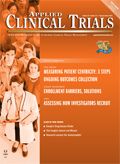
Improving Relationships and Diversifying the Site Selection Process
April 17th 2025In this episode of the Applied Clinical Trials Podcast, Liz Beatty, co-founder and chief strategy officer, Inato, discusses a number of topics around site engagement including community-based sites, the role of technology in improving site/sponsor relationships, how increased operational costs are impacting the industry, and more.
Behind the Buzz: Why Clinical Research Leaders Flock to SCOPE Summit
February 7th 2025In this episode, we meet with Micah Lieberman, Executive Conference Director for SCOPE Summit (Summit for Clinical Ops Executives) at Cambridge Innovation Institute. We will dive deep into the critical role of collaboration within the clinical research ecosystem. How do we bring together diverse stakeholders—sponsors, CROs, clinical trial tech innovators, suppliers, patients, sites, advocacy organizations, investors, and non-profits—to share best practices in trial design, program planning, innovation, and clinical operations? We’ll explore why it’s vital for thought leaders to step beyond their own organizations and learn from others, exchanging ideas that drive advancements in clinical research. Additionally, we’ll discuss the pivotal role of scientific conferences like SCOPE Summit in fostering these essential connections and collaborations, helping shape the future of clinical trials. Join us as we uncover how collective wisdom and cross-industry partnerships are transforming the landscape of clinical research.
FDA-Approved Gene Therapy Beqvez Shows Sustained Efficacy, Safety in Long-Term Hemophilia B Trial
April 17th 2025Beqvez (fidanacogene elaparvovec), an FDA-approved one-time gene therapy for hemophilia B, demonstrated sustained factor IX expression, low bleeding rates, and a favorable safety profile over long-term follow-up.